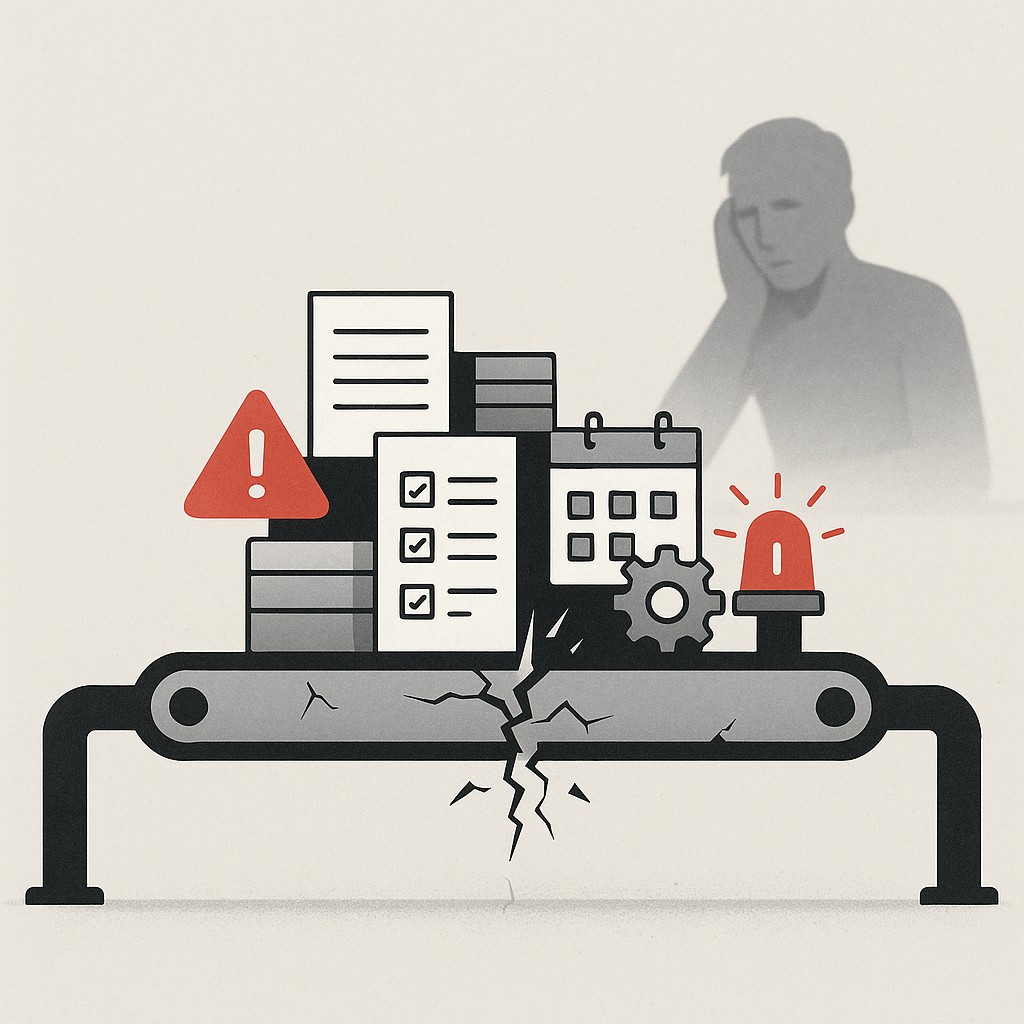Avoid Burnout in Toxic Workplaces: Protection Beats Passion
Avoid Burnout in Toxic Workplaces: Protection Beats Passion

Burnout Isn’t a Measure of Passion—It’s a Signal of Exposure
It’s April, and I’m reading a Glassdoor review that lands like a punch. “Burnout isn’t real if you love what you do.” I wish that were the rare exception. If you’ve spent any time building software in a startup, a big tech org, or even a so-called “healthy” company, you’ve probably heard something similar—if not from a manager, then in the group Slack or a skip-level Q&A. This line gets tossed around like it’s wisdom. It isn’t.
Let that sink in. If you feel your jaw tighten, you’re not wrong.
That’s not feedback. That’s gaslighting, turning exhaustion into a personal flaw, as if passion or attitude could override bad conditions. We’re told to “find meaning” in the grind, but this isn’t about meaning. It’s about being safe enough to do your best work, and knowing the difference between a hard push and real, structural risk.
If you’re being blamed for burning out, it’s not just a tough job. It’s a toxic system banking on your silence and self-doubt. Managers who frame burnout as a “personal problem” aren’t solving anything. They’re shifting liability, dodging responsibility, and leaving your boundaries unprotected.
Here’s what I’m betting on, and what this series will back up: how to avoid burnout in toxic workplaces. Burnout builds up from a mess of workplace factors—not just what’s inside your head or heart. Burnout isn’t caused by a lack of passion. It’s caused by a lack of protection. As these posts roll out, you’ll get specifics on sustainable rhythms, enforceable boundaries, trusted allies, and real exit options—including practical protection moves that stick. I’ve seen the doubts and fears: worrying what will happen if you document everything, fearing retaliation for pushing back. You deserve better than hoping “loving your work” alone will keep you safe. Protection beats passion, every time.
Avoid Burnout in Toxic Workplaces: Burnout Is a Systems Problem, Not a Personal Failure
Start with what’s in front of most engineers: a workload that never actually goes down, priorities that shift weekly, updates crashing onto your calendar with no warning, and commitments you “own” but can’t truly control. This isn’t about attitude or willpower. It’s built into the system. You’ll see burnout spike where the load stays high but actual resources to cope drop off—engineers know that’s a recipe for failure.
Think about rate limits, since we’re all engineers here. Every system has constraints. If requests keep piling up and you can never catch up, it’s only a matter of time before everything breaks down. That’s what happens to brains and bodies, too. Backpressure helps APIs stay reliable.
But in our jobs, what do you see? Shifting deadlines but no leeway, shifting priorities but never clarity on what should be dropped. And a kind of silent expectation that if you “love the mission,” you’ll find a way to absorb it all. That’s not how systems work. That’s how systems collapse. And on top of that, passion isn’t one-size-fits-all—some types fuel enrichment, but others tip straight into conflict when systems are out of balance. You can care deeply and still hit a wall if the upstream pressure never lets up or you’re not given permission to push back. No codebase gets better from ignoring error budgets. No engineer gets safer from ignoring limits.

Stay overloaded for long enough, and the effects show up fast. You catch yourself dropping details, second-guessing decisions, showing up less like the peer you want to be. The alignment between your values and your work fuzzes, then starts to crack. That’s not a character flaw—it’s physics.
It’s easy to talk yourself out of protecting your time. Maybe you figure “someone else will step up,” or worry that drawing a boundary will backfire. Fear of backlash is real, and the pressure to be a “team player” is heavy in most engineering orgs. But documenting your limits and naming the system issues isn’t rebellion. It’s risk reduction—like putting guardrails around prod. You’re not failing the team. You’re giving yourself a shot at lasting long enough to do any work that actually matters.
Protective Operating Mode: Four Steps to Sustainable Agency
Here’s the way I run it now: burnout protection strategies built on evidence, enforceable boundaries, support, and real exit options. You don’t have to flip a switch overnight or tell anyone what you’re up to. Start quiet. Make tiny moves. The pace is yours.
Begin with evidence. Start a paper trail. Document workload demands by logging your hours, workload, and decision points in plain terms—no drama, no editorializing. Timestamps help.
Stick to outcome framing. (“Delivered X in 4 hours after Y priority pivot.”) I had to learn the hard way to write what happened, not how I felt, so the record would stand up. This isn’t just CYA if things blow up. Keeping artifacts lets you catch patterns early and self-correct before it’s too late. Framing cuts down the back-and-forth cycle, making it easier to clarify what’s really happening—and if you need to escalate, you’re not relying on memory or gut feel. The point is to have receipts before trouble starts, so you don’t wind up in a “your word against theirs” standoff.
Next: enforceable boundaries. Set work boundaries by blocking calendar time for focus and for actual lunch. Cap your number of active workstreams—pick a ceiling and let folks know, “If you need this, here’s what moves.” Make boundary signals visible to the team. Use auto-responses. Book vacation like it’s a default, not a last resort. Treat PTO like any recurring meeting. If you don’t, that time gets filled fast.
Support is crucial. Find one safe person—a trusted colleague, mentor, or even a friend who can remind you you’re not crazy. Sometimes just saying it out loud to someone outside your chain of command cuts the problem down to size. Don’t do this alone.
Start your exit ramp. This isn’t about giving up. It’s contingency planning—like any engineer would do for a system that might not scale. Save cash. Cut expenses. Quietly get your ducks in a row—audit your work environment fit so you can choose the setting that lessens harm. Having options is what settles your nerves when things get tense or when you need real leverage.
It’s a bit of an odd story. I once spent a whole Saturday automating log rotation for a flaky service nobody liked—just so I could stop thinking about it over the weekend. Meanwhile, I hadn’t noticed my own brain was overdue for “log rotation,” too. It took me an embarrassingly long time to realize I was obsessing over uptime at work while letting myself operate at a constant, dumb level of personal alert. Sometimes, I still trip up and miss the signals.
Reusable scripts help lower the risk of pushback. For “no,” say: “I’m at capacity. Here’s what drops if I pick this up.” If escalation’s needed, your paper trail does the heavy lifting. “Here’s what was requested, here’s what shipped, here’s the impact.” When priorities need a reset: “Given X and Y, what’s top of stack and what moves?” Anchoring everything to evidence over emotion keeps your reputation and sanity intact—especially if you structure decision logs to capture alternatives, tradeoffs, and failure modes.
Translating Protection to Real-World Teams
Imagine you’re deep in a startup sprint, chasing five deadlines while new asks pop up daily. First move: set a capacity cap. Figure out what’s actually finishable this week and draw a line. Post a quick weekly status—just facts, no drama. Then ask for project tradeoffs out loud: “If we ship X, which Y moves to next week?” The real leverage comes from your evidence log; instead of arguing feelings, you lay out receipts and turn debate into decisions. Framing cuts down the back-and-forth cycle, so alignment happens quicker and expectations come into focus.
If you’re somewhere more researchy—where ambiguity is the rule and timelines run months—not weeks—protection takes a different angle. Start with a time-boxed exploration plan. Define your sandbox, then send a weekly alignment note to keep priorities from drifting off. The trick is making your paper trail visible and getting a sanity check from your safe person, especially before anyone’s work gets lost in the fog.
Worried about retaliation? Or about those meetings where you wonder if someone is clocking your every word? That’s valid. Most of us have been there. Keep a private log: action items, requests, responses. Summarize next steps in your own notes, apart from the official meeting doc. If unhealthy patterns repeat, escalate through HR when you need to. You don’t owe more exposure than you can handle, but you do owe yourself the clarity to know when escalation’s the right move.
Operationalize protection to prevent workplace burnout like you’d debug a hairy system. Do a fast calendar audit to spot energy leaks. Set your own meeting SLAs—don’t let every invite eat your time. Practice regular load shedding. Protect deep work sprints (give yourself time to focus). When work spikes, dump or defer the least important first—don’t negotiate away your stamina just to look loyal. This isn’t theory. It’s the only way I know to stay upright for the long haul.
If you want to share receipts without burning extra hours, use our AI to turn workload logs, meeting notes, and drafts into clean posts, updates, and docs fast.
Protection, Not Passion, Is How You Last
Let’s call time on that Glassdoor quote: “Burnout isn’t real if you love what you do.” No. To avoid burnout in toxic workplaces, recognize that it happens when you’re stuck in a system that punishes healthy boundaries and rewards stamina over sustainability. You aren’t the problem. The system is. When you protect your capacity, judgment comes back—and that lets you build, decide, and ship work that actually lasts.
Your first move can be this simple: at the end of today, write down what you worked on, just the facts. This is post 1 of 5 in an engineer burnout prevention guide, and I’ll be here daily, building every piece alongside you.
One thing I still can’t answer: why it took me so long to treat my own well-being with the same seriousness I gave production uptime. Maybe I’ll figure it out by post five. Or not.
Your craft is a long game. Your values don’t disappear just because your culture bends them out of shape. Protect your time and what you care about, now. You’ll keep your options—and your integrity—open, no matter how hard the system tries to convince you otherwise.
Enjoyed this post? For more insights on engineering leadership, mindful productivity, and navigating the modern workday, follow me on LinkedIn to stay inspired and join the conversation.
You can also view and comment on the original post here .
